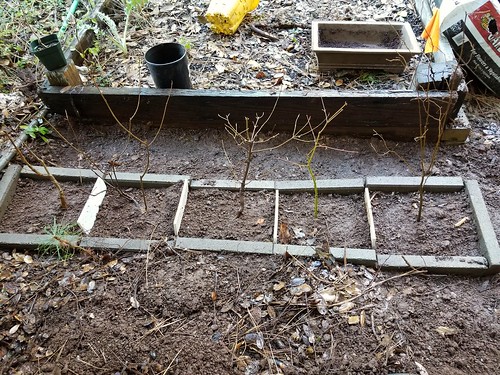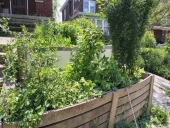A guild with a very small shrub as the overstory is in scale with this project. I used to be a landscape designer with a specialty in container gardens of native plants, and I would give three cautions: 1) Soil volume is a serious limitation here. 2) It's essential to choose one ecosystem type and stick with plants from that type of situation. 3) In most of the country, this container will have to be watered, so there is labor involved here for the recipient, even if you can find a grouping that excludes weeds.
About caution 1: I have seen trees and shrubs literally fill a container with roots until it bursts, with the entire container turned into woody root mass, and no room for anything else. Trees can be , and are, grown in containers, but it requires serious fertilization, and/or root pruning. If you want it to be self-sustaining, it has to be very small in total volume. Remember that the roots of any plant are at least as big in total mass as the top. So if you couldn't fit the top portion of your guild at maturity into a similar container, it will not be a sustainable situation.
About caution 2: Sticking to one type of biome is simpler if you start with one plant and think of its associates. So if strawberries are really important to you, start with them, not with your overstory. First off, I would use Alpine (wild type) strawberries but if you can't get those, use something that local gardeners recommend or will give you starts for.
If you start there, you have the stage set, and your biome chosen--woodsy soil in the sunny clearings of deciduous forest. Europe, the Eastern US, Eurasian mountains, all have this type of area, so you have a lot to choose from. Violets like the same habitat. For that matter, the miner's lettuce of western oak woodlands would like that soil and exposure as well.
https://www.quailseeds.com/store/p2/Miner%27s_Lettuce_%28Claytonia%29.html For a larger plant, you're going to want something from a woodsy deciduous habitat, not the dry limestone scrub where rosemary, sage and lavender live. A wild rose would be more adapted to this type of area. A gooseberry or currant would be at home there. Or for that matter a raspberry. Or just stick in a piece of wood for it to climb and go with the apios. The more shade-adapted you make the planting, the fewer weeds there will be to deal with. However, if you want to go with the raspberry and want it to have enough sun to bear fruit, one idea would be to use a combination of purslane and miner's lettuce(which in England is known as "winter purslane". You could get your larger plants in, and the soil all stable , then scatter seeds for both. The purslane will sprout when there is heat and moisture. The miner's lettuce will sprout when there is cold and moisture. (Int the west that is the winter rains.) They should mesh.
Another take on this theme would be to have blueberries (lovers of acidic peat/sand soil) with an understory of ligonberries, which are also from sunny peat-based ecosystems. The Ligonberry, aka lowbush cranberry, is hugely productive and beautiful, with shiny evergreen leaves and glossy red berries that are the classic accompaniment to Swedish pancakes.
https://raintreenursery.com/collections/lingonberries I would add Labrador tea to these for a fantastic evergreen tea plant from the same peaty areas.
Or to go the other direction, start with the more Mediterranean plants. Culinary Sage is super easy to grow, more cold-hardy and less fussy about drainage than lavender or rosemary, beautiful in all seasons, and started easily from cuttings. I started mine from leafy twigs I got in a package in the produce section of my local grocery chain. ("fresh cooking herbs") I stuck them in pots and now two years later they are covered with gorgeous purple flowers and butterflies of many kinds. Any evergreen however, will cast shade all year, which makes it hard to fit anything else in a small space. A trailing plant that goes over the edge to find sun might be the answer. Oregano? Thyme? Maybe even strawberries?
Perhaps the closest to your original idea would be a dwarf cherry or plum with strawberries underfoot. I would add a nitrogen fixer for both of those heavy feeders, and caution your friend not to remove the fallen leaves, as they will be important in maintaining fertility. For a nitrogen fixer, I don't know. Lupine? Sweet clover?
Easiest to keep going in the long run would be a prairie guild--Jerusalem sunflower or echinacea, grasses, and legumes. Maybe not what people would choose visually, but a perfectly balanced self-sustaining group.
Bottom line, it is hard to come up with a self-sustaining guild in such a small space. Or let me amend that. It's hard to come up with a self-sustaining guild that fulfills our desires in a small space. Most low growing food plants will be crowded out by grass after a season or two unless we intervene. So if the idea is to have a self-sustaining group that the recipient doesn't have to maintain, I would use an understory plant that is evergreen, has a dense canopy, and is at least 8" tall. Winter savory is a handsome one. Some oreganos and many sages would work. But in my career with plants, I have seldom seen plants lower than that compete with wind-sown grasses in a sunny situation. In nature, strawberries live where it's too shady for grass, or they are hidden in grass and seldom bear fruit.
It's all good, it just may not be what we as humans want from the plants we choose.

 16
16




 7
7




 6
6




 5
5




 6
6




 6
6




 7
7




 7
7




 4
4





 6
6




 7
7




 6
6




 8
8




 3
3




 2
2




 4
4




 2
2




 2
2




 6
6










 2
2




 4
4




 1
1










 1
1




 4
4




 2
2








